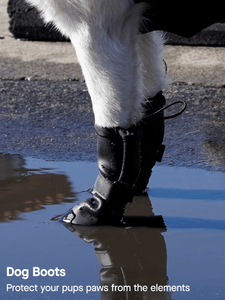Return to Blog
How to Choose the Right Winter Dog Boots for Your Canine Companion
By Canada Pooch on Sep 14, 2023
Just like us, our canine companions need adequate protection from harsh winter conditions. One of the most overlooked aspects of dog care during winter is ensuring their delicate paws remain safe and warm from ice, snow, and the cold environment.
This article aims to guide dog owners about the importance and functionality of winter dog boots. It discusses how the right kind of boots can not only protect your dog's feet but also contribute significantly to their overall health and comfort. The different considerations when selecting winter boots for your dog will also be highlighted in this guide, along with helpful tips for using and maintaining these paw-savers effectively.
Does Your Dog Need Boots for Winter?
Winter dog boots are a staple piece of winter gear for any dog owner who wants to provide their canine companion with the utmost comfort and safety during the chilly months of the year.
These specially designed dog shoes provide the necessary paw protection from harsh cold weather and are also durable enough to protect dogs' paw pads from salt, sharp objects, and slippery surfaces.
Protective Functions of Winter Dog Boots
Ultra Paws Durable Dog Boots, for example, are a popular choice amongst dog owners for their ability to offer a secure fit and provide excellent paw protection. These boots feature a rubber sole, which serves as a barrier against hot pavement and sharp objects, preventing injuries to your dog’s paw pads.
Besides that, waterproof dog boots are designed to keep your dog's paws cool and dry, preventing the risk of fungal and bacterial infections that can occur when your dog's paws are exposed to moisture for a prolonged period.
The Impact of Severe Winter Conditions on Your Dog's Paws
The dog booties that come with slip soles are a lifesaver for dogs who love outdoor activities. This type of sole provides the necessary traction, preventing your dog from slipping on icy or slick surfaces. It means your pup can continue playing outside in the snow without the fear of spraining or injuring their paws.
Some dogs may not immediately warm to the idea of wearing winter dog boots. As a loving dog owner, it's important to ease your fur baby into this new concept through dog training. Start by letting your dog wear the shoes indoors for short periods, gradually increasing the time as they get used to them.
Investing in a pair of quality winter dog boots, like the Ultra Paws Durable Dog Boots, is a wise decision for every dog owner. Your canine companion's health and comfort rely significantly on the paw protection these boots provide, making that winter walk an enjoyable experience for both of you.
Choosing the Right Winter Dog Boots for Your Dog
As any dog owner knows, our canine companions need their protection from harsh weather conditions. Winter dog boots not only protect from cold and snow but also hot pavement and sharp objects. But how do you ensure the boots you choose offer a snug fit, comfort, and ultimate paw protection? Here's your guide to choosing the right winter dog shoes for your furry friend.
Assessing Your Dog's Size and Breed Requirements
The right dog boots vary significantly based on your dog's breed and size. Smaller breeds like Chihuahuas and Yorkies require lightweight, well-fitted booties that allow for easy movement. Their petite paws call for soft, flexible materials. Medium breeds such as
Beagles and Corgis need sturdier construction and more weatherproofing for outdoor adventures. Large and extra large breeds like
Golden Retrievers or Great Danes require thick, rugged soles and durable uppers that can withstand their strength and energy.
Measure your dog's paws carefully and look for features like adjustability, reflective strips, and anti-slip soles that suit their specific needs. Dog boots should properly accommodate your dog's proportions and activities to provide the comfort and protection their paws require. Proper fitting based on breed and size is key.
Material Considerations: What Your Winter Dog Boots Should be Made of
Rubber soles are a common material in many dog booties due to their durability and flexibility. Waterproof dog boots with rubber soles offer excellent protection from cold weather, snow, and sharp objects. Look for boots with a textured sole to provide extra grip on icy or wet surfaces.
Season dog boots made of breathable material are a great choice. They help keep the paws cool in the summer and warm in the winter. The boots should also be easy to clean, especially if your dog likes to explore muddy areas. Some winter dog boots come with reflective strips for added visibility during night walks.
Choosing the Right Boot Fit for Your Dog's Comfort
A good winter dog boot should not only protect but also be comfortable. For a seamless fit, choose boots that have adjustable straps or Velcro closures. This will ensure a secure fit without overly constricting your dog’s paws.
Before making a purchase, allow your dog to "try on" the boots to check for any signs of discomfort. Be patient, as it can take some time for your pet to adjust to wearing shoes. Remember, comfort wins over style – although many winter dog boots offer both.
Remember, investing in a good quality boot can save you from expensive vet bills due to paw injuries. So, choose wisely for your dog’s comfort, protection, and happiness.
Using Winter Dog Boots: Tips and Tricks
Choosing the right winter dog boot for your canine companion can feel overwhelming with the variety of options available. Whether it's waterproof dog boots, snow shoes, dog socks, or even classic-style waterproof dog shoes, each option has its own benefits. Understanding your dog's needs and recognizing the different features each winter gear option provides will help you in your selection.
Check the boots for a secure, snug fit. Winter dog boots that are too loose can fall off during walks or play, while boots that are too tight can be uncomfortable for your dog.
Check the sole of the boot for a good grip. Winter boots with silicone or rubber soles provide better traction on ice or snow. They should also protect the paw pads from sharp objects hidden under the snow.
Training Your Dog to Wear Boots
Once you select the perfect winter dog boot, it's important to get your canine companion accustomed to wearing them. This can be
achieved through positive reinforcement and gradual exposure.
Start by having your dog wear the boots indoors for short periods of time. Reward their tolerance with a treat or praise. Slowly increase the amount of time spent wearing the boots until your dog feels comfortable.
Maintaining and Cleaning Your Dog’s Winter Boots
Winter dog boots may need frequent cleaning due to exposure to dirt, snow, and ice-melting chemicals. Cleaning them will lengthen their lifespan and prevent skin irritations on your dog’s paws.
Most winter dog boots are easy to clean. Simply remove any loose dirt or debris and then wash with lukewarm water and mild soap. Thoroughly air dry the boots before the next use to avoid mildew.
When and Where to Use Winter Dog Boots
Winter dog boots are not just a winter accessory but also provide year-round protection. They defend the paw pads against hot pavement, rough terrain, and sharp debris during walks or hikes.
In cold weather, the boots provide insulation, keeping the paws dry and warm. They also protect against harmful chemicals found in ice-melting agents.
Lastly, winter dog boots are perfect for senior dogs or dogs with mobility issues to provide extra traction on slick surfaces, preventing falls and injuries.
Winter dog boots can be a game-changer for your canine companion, offering comfort, protection, and stability in various weather conditions.


